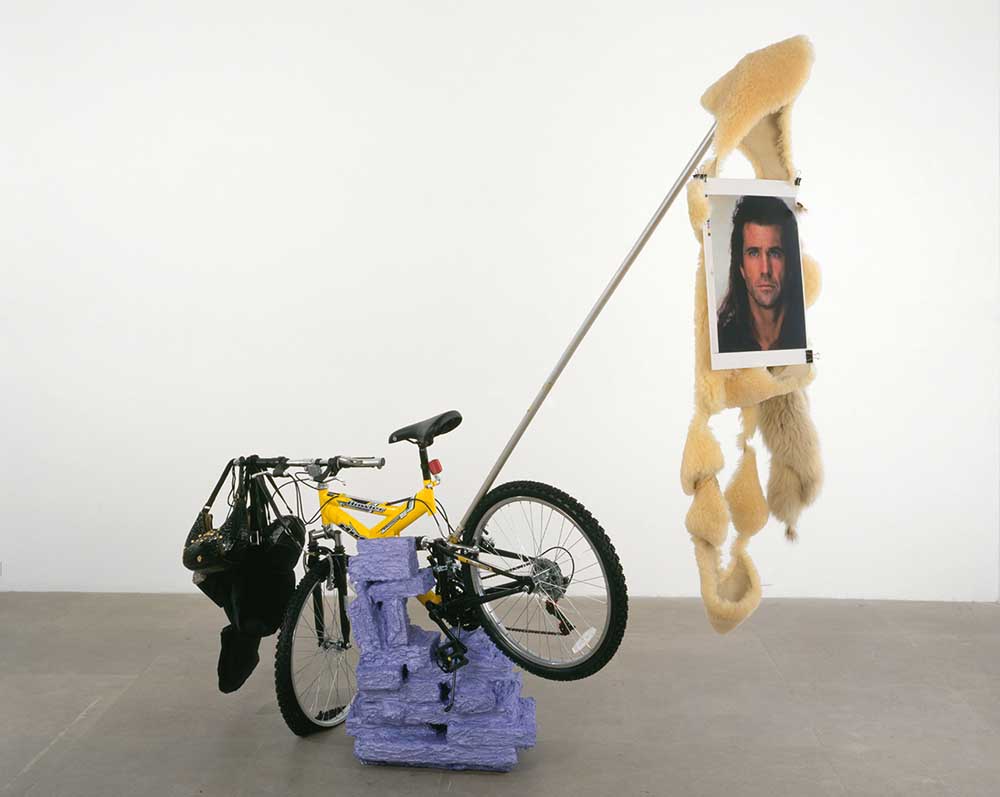The acclaimed, exasperating sculptures of Rachel Harrison get a star turn at the Whitney Museum
Published 10:45 am Friday, December 13, 2019

- “Huffy Howler” (2004) by Rachel Harrison. Wood, polystyrene, cement, acrylic, Huffy Howler bicycle, handbags, rocks, stones, gravel, brick, one sheepskin, two fox tails, metal pole, wire, pigmented inkjet print, and binder clips. MUST CREDIT: Photo by Jean Vong/Whitney Museum of American Art
NEW YORK – Sculpture proposes solutions to problems. Empty space and gravity, for example. But there’s also the problem of social life (how to share space with other people) and the problem of entropy (things fall apart; sculpture tries not to).
You could say that Rachel Harrison, one of our leading sculptors, proposes specific solutions to all these challenges. But even more, her work expresses a conviction – at once liberating and daunting – that there are no solutions. “That the world is out of joint,” wrote Theodor Adorno, “is shown everywhere in the fact that, however a problem is solved, the solution is false.” To look at Harrison’s work is to grasp his meaning immediately.
If you depend on art to make sense of the world, Harrison’s sculptures will probably disappoint, and possibly aggravate. It’s not that her work is unintelligent. Rather, it feels like the inside of a very smart person’s head after a nasty concussion. Things once cohered, her works suggest, and they might cohere yet, only … this dizziness won’t go away.
Harrison’s art – mostly sculpture but also photographs, installations and drawings – is the subject of a major retrospective at the Whitney Museum of American Art this winter. “Can this be art?” you may wonder as you make your way through the exhibit, parts of which resemble a disheveled corner of a megastore where a kid in a Halloween costume spilled his soda and half the contents of a shelf tumbled on top of the uniformed guy with a mop who came to clean up.
The reflexive question – is it art? – is both mundane and meaningless (the answer would change what, exactly?). But Harrison wants you to ask it. She uses it as bait. In front of her work, the question occasions a conceptual collapse, which in turn provides the rubble she roots around in, like a Visigoth in ancient Rome, and rebuilds into her fabulous three-dimensional puns, comedic mishaps and shaggy dog stories.
A typical work (any straight-up description risks being mistaken for an inventory of someone’s basement) may combine bare wooden boxes, food cans, and big abstract blobs of Styrofoam coated in cement and brightly painted. Wigs and mannequins also appear, along with an orange vacuum cleaner, a photograph of Mel Gibson in “Braveheart,” a bicycle, a cup holding dirty paint brushes, an old telephone and a Dick Cheney mask.
I love the results. They are not just hard to ignore, they’re involving. Once you notice them, it takes an act of will not to walk all the way around them. What’s more, without ever arriving at a reassuring proposition about the world, they rearrange your assumptions about what it means to be in it.
They do more, that’s to say, than merely feed into the spectacle of art and society. They squirm and wriggle out of our confining expectations, striving all the while to create new situations.
Obvious underlying influences include Picasso’s “Glass of Absinthe,” Marcel Duchamp’s “Bicycle Wheel” and the assemblages of Robert Rauschenberg. More specifically, Harrison’s work shares conceptual affinities with an array of more recent artists, all interested in process over product, in sculpture as theater and in the struggle to merge sculpture with social and political life. They include Bruce Nauman, David Hammons, Chris Burden, Richard Serra, Mike Kelley, Martin Kippenberger and Franz West.
Imagining that conga line of male artistic forebears bent into a circle conjures “Circle Jerk,” a 1989 sculpture that is not in the show but is pictured in the catalogue. It consists of a long fluorescent light fixture piercing, at an angle, the seat of a metal folding chair. What violent force propelled it there?
The piece, with its pungent title, provides an early example of Harrison’s sense of sculpture as either the anticipation or the aftermath of an action. The first work in the Whitney’s show provides another example. “Dinner” is – prepare to be grossed out – the contents of an actual meal (beer, vegetable strudel, lamb shish kebab, arugula salad, cheesecake with strawberries) which Harrison transferred, in 1991, from a restaurant’s plates into Ziploc bags and later into Mason jars. Needless to say, 28 years on, the food is unrecognizable.
Five years later, a related fascination with the idea of sculpture as aftermath fed into a room-size installation that was given the following improbable title: “Should home windows or shutters be required to withstand a direct hit from an eight-foot-long two-by-four shot from a cannon at 34 miles an hour, without creating a hole big enough to let through a three-inch sphere?”
The question appeared in a newspaper article about structural preparedness for extreme weather. Harrison’s installation – her first solo show – has been re-created at the Whitney. It consists of a slapped-together wooden room adorned with cans of peas, papier-mâché blobs and photographs of sidewalk trash bags taken on a trip to England. It’s hard to say whether the installation constituted an auspicious beginning: Had I seen it at the time, I don’t think I would have claimed it as the work of an exciting new prospect. But it has elements – the colorful blobs, the mass-produced objects, the use of photographs, a hypersensitivity to the dynamics of access and obstruction, and the feeling of a private, improvised response to a wider, unseen disaster – that Harrison went on to develop in later, more commanding works.
What is sculpture? Ad Reinhardt quipped that it was something you bump into when you back up to look at a painting. The insult lingers in the mind because it pinpoints two foundational truths: Sculpture is three dimensional and it’s situational. It doesn’t just stand in space; it claims it for itself. Once a sculpture is installed, there’s no escaping it: We’re in the round, force fields interacting – me, you and this thing.
This is something Harrison thinks hard about. In her 20s, she was impressed, according to Peter Schjeldahl, who wrote a 2014 profile of her in the New Yorker, by a performance piece by Adrian Piper. Piper had put on clothes she had soaked for a week in cod-liver oil, milk and eggs and walked into the New York City Subway at rush hour. Voilà! Sculpture!
A more effective way to claim space – or to clear it – is hard to imagine.
I remembered the reference to Piper as I walked into the exhibition’s final room. The room preceding it had set out some of Harrison’s best pieces – including “Huffy Howler,” “Hoarders,” and “Alexander the Great” (each is more or less indescribable, but if they have anything in common, it’s a feeling for combinations of careeningly bright color and wildly dissonant textures) – with ample space between them, on a floor marked up like a street map. (The staging was inspired, apparently, by the minimalist set of Lars Von Trier’s film “Dogville.”) The implication – that sculptures can be thought of as akin to actors playing theatrical roles on a set, or as discrete houses in an orderly locale – is aggressively overturned in the final room, at the center of which is a muddled congregation of brightly colored sculptures, all of them cordoned off by a circle of cheap folding chairs facing outward.
No one I could see had bothered to take up the unspoken invitation – to turn away from the art and take a seat – presumably because it would have seemed rude. But isn’t that funny? Why, I wondered, are we still being polite? What on earth do we think we owe art?
I see a lot of Samuel Beckett in Harrison’s sensibility. Her sculptures are (expensive) objects, not human beings, so it’s an unseemly comparison to make, but they take up social space the way the homeless do: accusingly, incongruently, heartbreakingly. They are like refugees from a failing state – the beloved country of meaning.
As assemblages, they are more artful – both formally and conceptually – than they initially appear. But they can also seem bracingly indifferent to your opinion of them. Sometimes, they feel like panicky yet impressively resourceful responses to trauma, or to spiraling feelings of hopelessness. Other times (the metaphors keep coming), they feel like angry speech bubbles made solid (this kind: $!!%&*@#!!!).
In the catalogue, Whitney Museum director Adam Weinberg describes Harrison’s vision of sculpture – her “tactics” – as “centrifugal: they spin out into the world beyond the museum.” That feels right. In undoing expectations of what art should look like, of how it should tidy up the world, the work eats through definitions of art and non-art like a rat burrowing through museum insulation. There is plenty of humor here, but the laughter is dark.
It’s strange, the way we identify with sculpture. Even before leaving the gallery, you may feel as if she has dumped you outside, on the sidewalk, like a bulging bag of trash.
– – –
“Rachel Harrison Life Hack”
Through Jan. 12 at the Whitney Museum of American Art, New York. whitney.org
art-harrison









